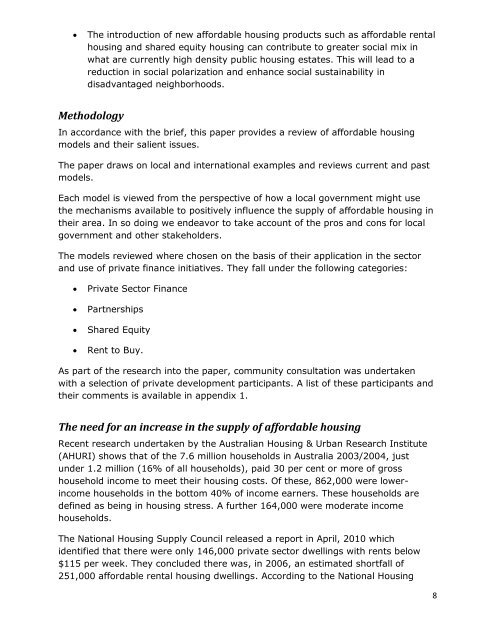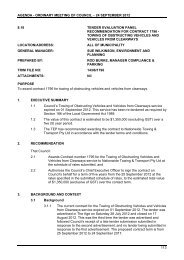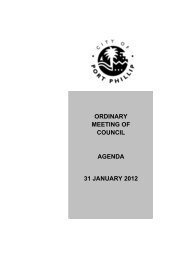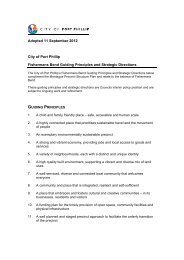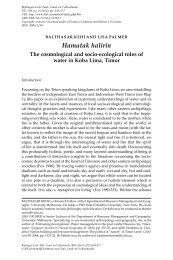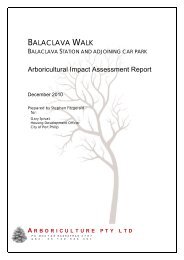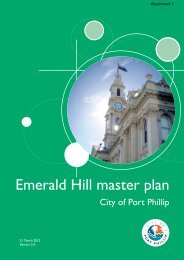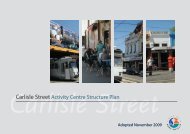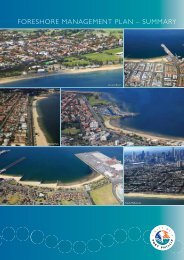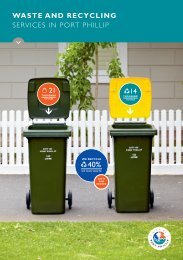affordable housing development models - City of Port Phillip
affordable housing development models - City of Port Phillip
affordable housing development models - City of Port Phillip
Create successful ePaper yourself
Turn your PDF publications into a flip-book with our unique Google optimized e-Paper software.
The introduction <strong>of</strong> new <strong>affordable</strong> <strong>housing</strong> products such as <strong>affordable</strong> rental<br />
<strong>housing</strong> and shared equity <strong>housing</strong> can contribute to greater social mix in<br />
what are currently high density public <strong>housing</strong> estates. This will lead to a<br />
reduction in social polarization and enhance social sustainability in<br />
disadvantaged neighborhoods.<br />
Methodology<br />
In accordance with the brief, this paper provides a review <strong>of</strong> <strong>affordable</strong> <strong>housing</strong><br />
<strong>models</strong> and their salient issues.<br />
The paper draws on local and international examples and reviews current and past<br />
<strong>models</strong>.<br />
Each model is viewed from the perspective <strong>of</strong> how a local government might use<br />
the mechanisms available to positively influence the supply <strong>of</strong> <strong>affordable</strong> <strong>housing</strong> in<br />
their area. In so doing we endeavor to take account <strong>of</strong> the pros and cons for local<br />
government and other stakeholders.<br />
The <strong>models</strong> reviewed where chosen on the basis <strong>of</strong> their application in the sector<br />
and use <strong>of</strong> private finance initiatives. They fall under the following categories:<br />
<br />
<br />
<br />
<br />
Private Sector Finance<br />
Partnerships<br />
Shared Equity<br />
Rent to Buy.<br />
As part <strong>of</strong> the research into the paper, community consultation was undertaken<br />
with a selection <strong>of</strong> private <strong>development</strong> participants. A list <strong>of</strong> these participants and<br />
their comments is available in appendix 1.<br />
The need for an increase in the supply <strong>of</strong> <strong>affordable</strong> <strong>housing</strong><br />
Recent research undertaken by the Australian Housing & Urban Research Institute<br />
(AHURI) shows that <strong>of</strong> the 7.6 million households in Australia 2003/2004, just<br />
under 1.2 million (16% <strong>of</strong> all households), paid 30 per cent or more <strong>of</strong> gross<br />
household income to meet their <strong>housing</strong> costs. Of these, 862,000 were lowerincome<br />
households in the bottom 40% <strong>of</strong> income earners. These households are<br />
defined as being in <strong>housing</strong> stress. A further 164,000 were moderate income<br />
households.<br />
The National Housing Supply Council released a report in April, 2010 which<br />
identified that there were only 146,000 private sector dwellings with rents below<br />
$115 per week. They concluded there was, in 2006, an estimated shortfall <strong>of</strong><br />
251,000 <strong>affordable</strong> rental <strong>housing</strong> dwellings. According to the National Housing<br />
8


